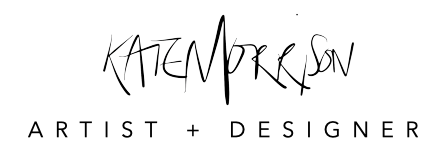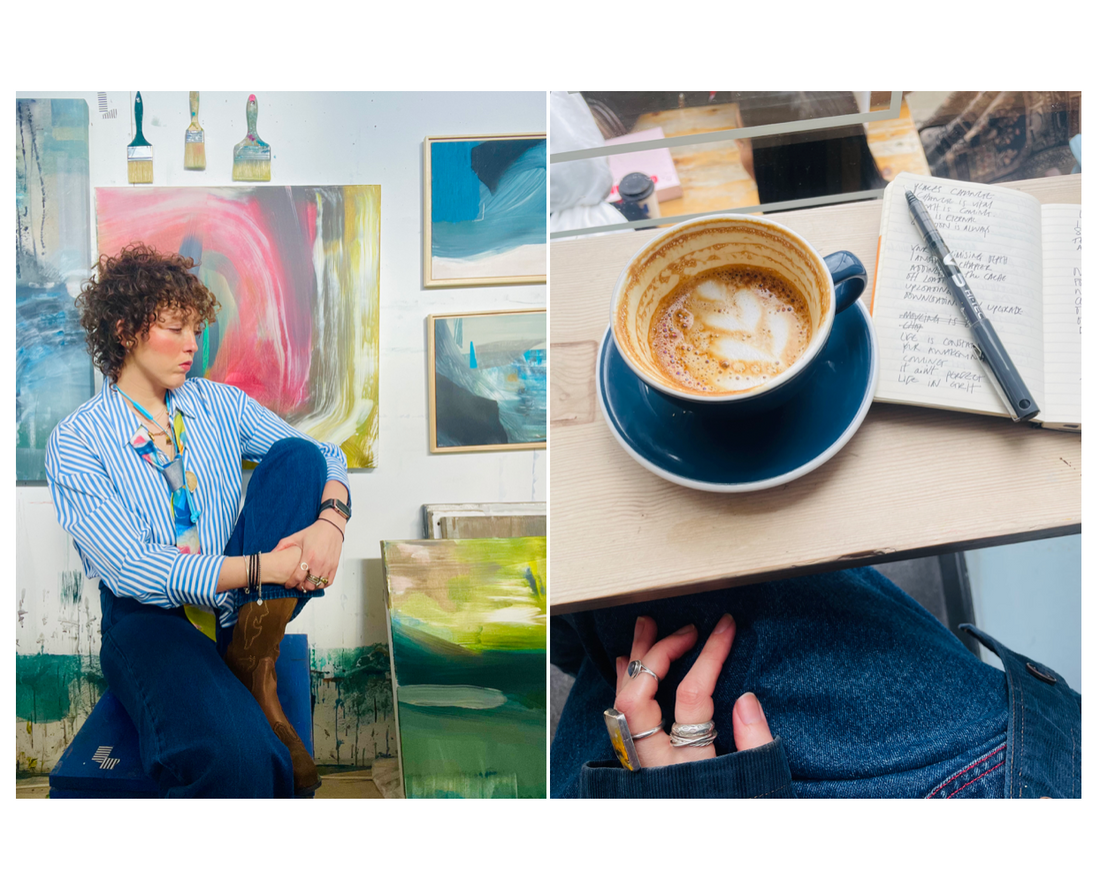Q: What draws you to abstract expressionism?
Honestly, I think I paint to make sense of things I can't articulate - feelings, memories, that strange undercurrent of emotion you can't quite place. Abstraction has always given me the opportunity and space to explore the warp and weft of multiple inspiration avenues at the same time. There's freedom in not having to explain everything.
Q: Your background is in textiles - how does that influence your work now?
Absolutely! Training in textile design and as a weaver was a game changer in connecting with how my brain works, it taught me how to build things slowly and from scratch, how to find rhythm in repetition, unpick and to pay attention to surface finish and texture. Even now, I will still approach a new piece like it’s a woven surface — I layer, I pull things back, I let the work build itself up - It’s not tidy! It never has been! - although my woven work is meticulously detailed and accurately constructed, its fun to balance both aspects of my work!

Q: You’ve moved around a lot - does that sense of movement appear in your art?
Definitely. Place is something I think about a lot, but not always in a literal way. It’s more about how a place feels - its atmosphere, its imprint. You know that gut feeling of belonging and dislocation all at the same time? I think that’s why my work ends up being about fragments, tactile memories, and the moments between places. My life’s had a lot of unpacking and repacking. Lots of information constantly replaying at all times in my mind, a bit like static on a tv - White noise and glitching - its always going to seep into my work.
Q: Do you begin with a plan when you start a painting?
(Laughs) I never have a plan - not really, it would only get in the way! Other than the sense of place and documentation I tend to start with a few sketches re tracing my steps through my books and collections then honing in on a feeling or a colour, but then when I start, the painting takes over. I follow it, really. Sometimes it’s smooth, sometimes it’s like wrestling a bloomin wild boar! But I trust the process, even when it gets a bit feral.
Q: What do you want people to feel when they see your work?
Great question! I want them to feel something before they try to think about it. That moment of recognition or emotion you can’t quite place - but you know it’s there. You know? It’s like when a groovy bass line hits you, or a smell takes you back to a family holiday 15 years ago. That sense of nostalgia, thrill of exploring a new city or the relief of coming home, you don’t have to understand it. You just need to let yourself feel it.
Q: Your work is often described as ‘emotional’- do you see it that way?
(Laughs) Yes, but not in a dramatic, all-caps kind of way. It’s more of a quiet emotion - the stuff that lingers in your chest, not your face. My work isn't about grand gestures. It’s about the small shifts, the mundane moments in everyday life. The weight of a colour, the tension in a line. The emotional undercurrent that hums underneath things, I like to discover the big dirty underbelly of places.
- Tho! Describing my work as emotional is like saying everything we do in life isn’t - we're all just trying to connect at the end of the day. I mean we’re human right?!

Q: You often say your work is made for interiors rather than galleries - can you talk about that?
I make work for real spaces, where people live. Where it becomes part of the rhythm of a home, not something you tiptoe around. I love the idea of someone living with a painting - seeing it in different lights, at different times, maybe finding something new when they least expect it. It’s about intimacy. Art that sits quietly with you. I love the romanticism of creating a contemporary artefact, a core memory of peoples peripheral narratives. - Wow! - sounds quite deep doesn’t it! But it’s something that has fascinated me from a very young age, what we surround ourselves in how we live and curate our memories each human and home is completely unique.
Q: And finally - how do you react when people compliment your work?
Oh, you know I’ll probably say something awkward like, “Oh, it’s just a bit of colour, really,” and then think about it for three days kicking myself <Laughs> I’m British - it’s in the contract.

